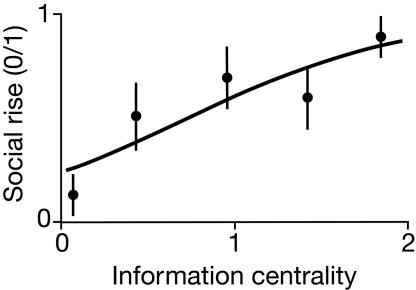Fig. 2.
Logistic regression for binary rise in success (response) as a function of information centrality (predictor) in long-tailed manakin social networks. Early connectivity predicted fate (social rise) 4.8 years later on average. A male's information centrality score was relative to that of others in the same category for the 2-year timeblock (Fig. 1) in which he was first seen interacting. Curve plots probability of success as a function of information centrality (logit[p] = −1.21 + 1.6 × information centrality). Points are response averages binned in groups of 10 (±SE). A male's odds of later social rise were 4.96 times higher for each unit increase in his relative information centrality (scale 0–2). In contrast, information centrality in the final timeblock subnetwork was not correlated with contemporaneous success.

